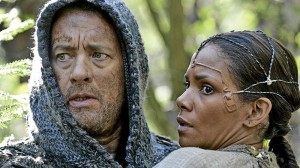We had a “dizzyingly” good time at the movies last Dec. 11, watching Tom Tykwer and the Wachowski brothers’ latest cinematic brain-tickler, “Cloud Atlas,” top-billing Tom Hanks, Halle Berry, Hugh Grant and others in an amazing multiplicity of roles.
Hanks’ presence was the movie’s initial attraction for us, since he acts on the big screen only occasionally these days. But, we soon found ourselves caught up in an embarrassment of riches of other wonders, especially the story and production’s wondrous way of constantly traveling both forward and backward—and forward again—in time.
The time-travel factor is key to the film’s central thematic interest in the eternal battle between good and evil that continues to be waged on this planet—and beyond—to this very day.
In this regard, the movie’s penchant for sometimes casting the same actor in both hero and villain roles is pointedly relevant. It’s the filmmakers’ way of saying that the seeds of both goodness and evil reside in all of us, and the historic battle is in fact being waged within ourselves.
Outcome
As the film hops, skips, jumps and arabesques through the centuries and eons, it shows the bad guys winning more times than losing—a bad augury for the battle’s ultimate outcome. And yet, the most futuristic episode involves a “mindless” clone who, in the end, turns out to be quite the revolutionary and visionary—so, all bets are still on!
In the process of telling its agile and antic tale, “Cloud Atlas” vivifies a number of verities and life lessons that may feel and sound rather pat and predictable when read and heard, but are stunningly, breathtakingly valid and vivid when dramatized on the big screen.
The film also comes up with a number of arresting and instructive conjunctions, like a woman from the future saving the family of a man from the past, a black man coming to the rescue of a “superior” white, a clone without a heart falling in love, old and “inutile” folks proving that they’ve still got what it takes to mount a revolution—etc.!
Renewed hope
It’s the “revolutionary” nature of the film’s storytelling that is underscored by the production most of all, because it’s the periodic change in global systems of governance and control that, the movie implies, can give mankind the renewed hope that, the next time around, its story will end up on the side of the angels!
Another key theme is the “fact” that all men throughout history have at least the potential to be able to interact with and help everybody else, even if, chronologically speaking, they’re physically separated by epochs and eons. Moses coming to the aid of Madonna, who in turn can help Helga the Humanoid on Planet Mars? Hope springs!
To be sure, the film’s constant time travels can sometimes perplex viewers and make them want to get off at the next stop.
But, less testy viewers who opt to stay onboard until the big reveal should be glad that they’ve kept pace with the film’s multilevel storytelling, because the insights they gain therefrom are correspondingly complex—and rewarding!
